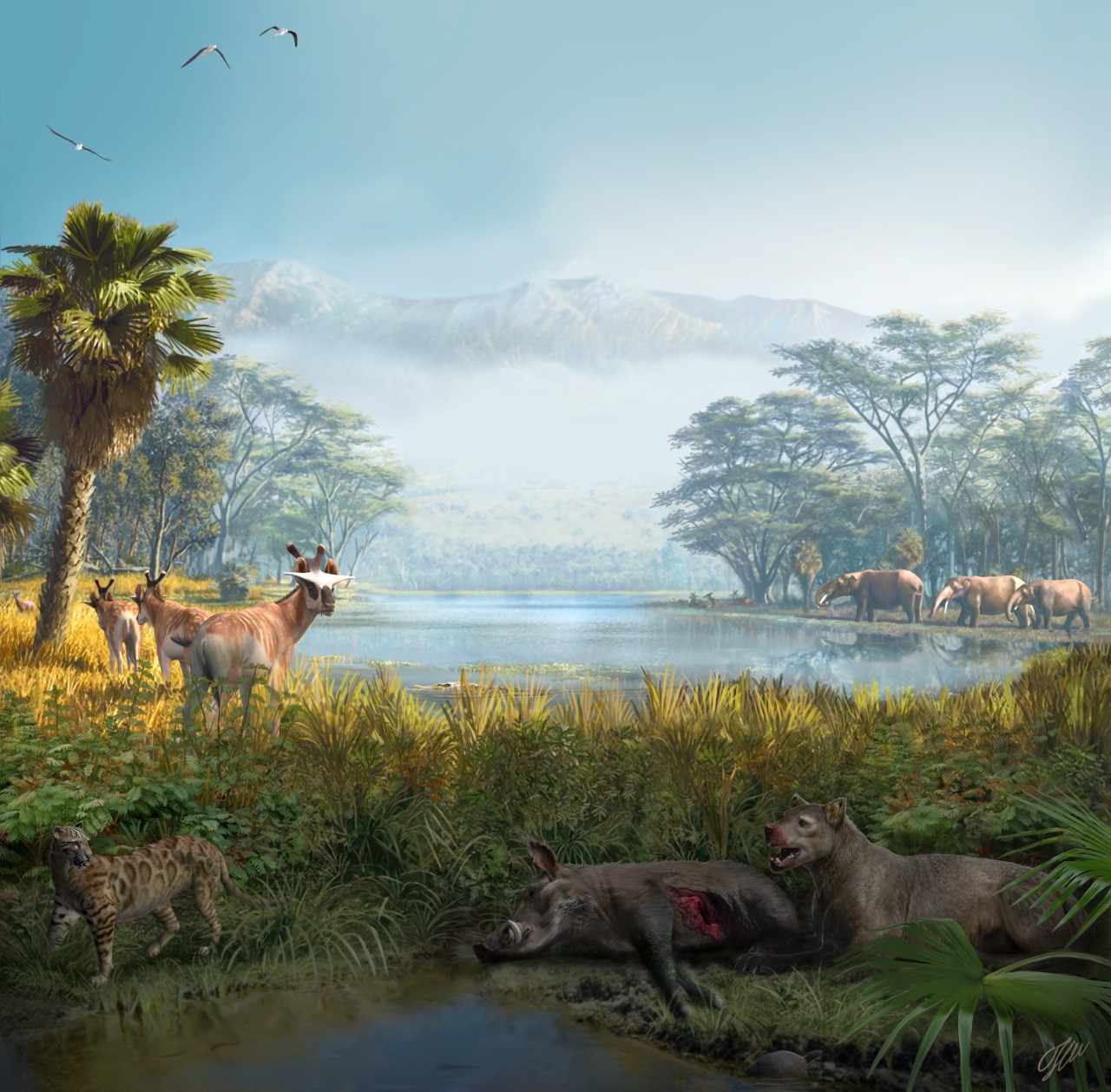

Paleoecological reconstruction of the local ecosystem and extinct fauna at the Els Casots paleontological site in Spain, dated to 16 million years ago (illustration: Oscar Sanisidro/University of Alcalá (UAH))
Climate change on the prehistoric Iberian Peninsula caused the loss of midsized prey and reduced the supply of food for carnivores, making them more likely to disappear. A study based on fossil records warns of the cascading effect of extinctions in the present.
Climate change on the prehistoric Iberian Peninsula caused the loss of midsized prey and reduced the supply of food for carnivores, making them more likely to disappear. A study based on fossil records warns of the cascading effect of extinctions in the present.

Paleoecological reconstruction of the local ecosystem and extinct fauna at the Els Casots paleontological site in Spain, dated to 16 million years ago (illustration: Oscar Sanisidro/University of Alcalá (UAH))
By André Julião | Agência FAPESP – The Iberian Peninsula, currently the location of Portugal and Spain, was a paradise of biodiversity 20 million years ago. Animals similar to today’s African megafauna, such as ancient Iberian versions of the rhinoceros, elephant and felines, grazed or hunted in environments filled with prey and predator species.
Around 15 million years ago, however, the landscape began to change as the climate cooled and became increasingly dry. Dense forest gave way to more open vegetation, favoring large herbivores, which thrived while midsized herbivores disappeared, leaving carnivores with less prey. It was harder to hunt gomphotheres (four-tusked ancestors of modern elephants) weighing 2 tons and towering 3 m above the ground than deer weighing 30 kg, for example.
This view of a remote past is reconstructed in detail by a group of researchers supported by FAPESP in an article published in the journal Ecology Letters.
The study, led by scientists affiliated with the State University of Campinas (UNICAMP) in Brazil, in collaboration with colleagues at institutions in Spain and Sweden, reconstructed and analyzed the longest timeline to date, between 20 million years ago and the present day.
The analysis was possible thanks to a vast database on mammals in the period compiled from fossil records from the region, and one of the most widely studied and most comprehensive in the world.
The Iberian Peninsula is rich in fossils of extinct animals, enabling researchers to understand how ecosystems changed and species evolved millions of years ago.
“Fossil records abound at many paleontological sites. The database we analyzed contains data for a wide array of species native to the region with a very high resolution. For each group of animals, it contains detailed information on features such as size, diet, type of locomotion, and so on, enabling researchers to infer predator and prey species for any given location and period, and how these changed over time,” said João Nascimento, first author of the article and a PhD candidate at the Institute of Biology (IB-UNICAMP) with a scholarship from FAPESP.
“The point of the project is to understand how ecological interactions can influence large-scale evolutionary patterns, especially the emergence and extinction of species. The main difficulty in this kind of study is that information on how species interacted in the remote past is scarce. We set out to fill this knowledge gap using statistical tools and mathematical models applied to fossil data,” said Mathias Pires, last author of the article and a professor at IB-UNICAMP supported by FAPESP.
Food web simplification
The process that occurred in Iberia over a period of some 15 million years is known as food web simplification and is ongoing in present-day ecosystems. It was a process of homogenization, in which a few generalist species replaced rare specialist species.
“Similarly, we can see now that in some populations, the composition of herbivore communities and of the communities of predators that feed on them is changing. On the ecosystem scale, this has a far greater impact than the loss of one or two species,” Pires said.
The researchers set out to see whether predator longevity correlated directly with the risk of predator extinction as a consequence of the changes in herbivore communities. Their mathematical models showed that the animals that disappeared from the fossil record most frequently over time were those with less available prey.
“Our findings clearly evidence the influence of ecological interactions on extinction patterns over evolutionary time scales, suggesting the need to take into account the broadest possible ecological context when conservation strategies are developed to protect predators in their ecosystems,” Fernando Blanco, second author of the article and a researcher at the University of Gothenburg in Sweden, said in a press release.
According to the authors, the study underscores the need to conserve species-rich prey populations in order to safeguard predator populations and maintain structurally robust ecological networks.
“The extinction of a group of species has a cascading effect on others, which is extremely harmful to ecosystems and ecosystem services. We have a unique opportunity to understand what happened in the past and what’s happening now as a basis for intervening to prevent new extinctions,” Pires said.
The article “The reorganization of predator-prey networks over 20 million years explains extinction patterns of mammalian carnivores” is at: onlinelibrary.wiley.com/doi/10.1111/ele.14448.
Republish
The Agency FAPESP licenses news via Creative Commons (CC-BY-NC-ND) so that they can be republished free of charge and in a simple way by other digital or printed vehicles. Agência FAPESP must be credited as the source of the content being republished and the name of the reporter (if any) must be attributed. Using the HMTL button below allows compliance with these rules, detailed in Digital Republishing Policy FAPESP.





